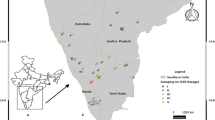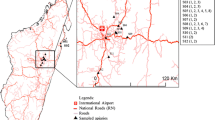Abstract
Based on allozyme electrophoresis at the Pgm locus and nuclear ribosomal DNA (ITS2) sequences, we studied the genetic variation of the two-spotted spider mite Tetranychus urticae Koch collected on rose bay, Nerium oleander L. (Apocynaceae), from several localities around the Mediterranean basin. In addition, we compared these results with those of Navajas et al. (1998) and Tsagkarakou (1997) who collected from several other host plants from the Mediterranean. In the western part of this area (Spain, France, Tunisia), we found the individuals collected from rose bay to be clearly genetically differentiated from other samples. No evidence of such host-associated differentiation was detected in the eastern Mediterranean (Italy and Greece). The genetic differentiation of mites collected on rose bay was investigated further by studying the reproductive incompatibilities between populations in Greece and in France and a laboratory strain reared on bean, Phaseolus vulgaris, in France. Reciprocal crosses performed between these strains revealed variable levels of incompatibility, spanning from partial to complete reproductive isolation. In all cases incompatibility was asymmetric. We designed a test based on double-mating to establish the fertilization status of females in fully incompatible crosses. These crosses showed that the females had been inseminated, which suggests that the barrier to reproduction is not of a prezygotic behavioral nature. The data raises the question of the relative role of ecological factors (host plant) and geographical distance, in the ongoing differentiation process potentially leading to speciation.
Similar content being viewed by others
References
Bolland, H.R., Gutierrez, J. and Flechtmann, C.H.W. 1998. World Catalogue of the Spider Mite Family (Acari: Tetranychidae), with references to taxonomy, synonymy, host plants and distribution. Brill Academic Publishers, Leiden.
Breeuwer, H. 1997. Wolbachia and cytoplasmic incompatibility in the spider mites Tetranychus urticae and T. turkestani. Heredity 79: 41–47.
Chadha, Y.R. 1972. The wealth of India: a dictionary of Indian raw materials and industrial products. Council for Scientific and Industrial Research, New Delhi.
Coyne, J.A. and Orr, H.A. 1998. The evolutionary genetics of speciation. Phil. Trans. R. Soc. Lond. B 353: 287–305.
de Boer, R. 1985. Reproductive barriers. In: World Crop Pests. Spider mites: their Biology, Natural Enemies and Control, W. Helle and M.W. Sabelis (eds), Vol. IA, pp. 193–200 Elsevier Science Publishers, Amsterdam.
Fry, J.D. 1990. Trade-offs in fitness on different hosts: evidence from a selection experiment with a phytophagous mite. Am. Nat. 136: 569–580.
Fry, J.D. 1999. The role of adaptiton to host plants in the evolution of reproductive isolation: negative evidence from Tetranychus urticae. Koch. Exp. Appl. Acarol. 23: 379–387.
Gotoh, T., Bruin, J., Sabelis, M.W. and Menken, S.B.J. 1993. Host race formation in Tetranychus urticae: genetic differentiation, host plant preference, and mate choice in a tomato and a cucumber strain. Entomol. Exp. Appl. 68: 171–178.
Helle, W. 1967. Fertilization in the two-spotted spider mite (Tetranychus urticae: Acari). Entomol. Exp. Appl. 10: 103–110.
Helle, W. and Pieterse, A.H., 1965. Genetic affinities between adjacent populations of spider mites. Entomol. Exp. Appl. 8: 305–308.
Helle, W. and Pijnacker, L.P. 1985. Parthenogenesis, chromosomes and sex. In: Spider mites, their biology, natural enemies and control: World Crop Pests, W. Helle and M.W. Sabelis (eds), Vol. 1A, pp. 129–139, Elsevier, Amsterdam.
Itami, J.K., Craig, T.P. and Horner, J.D. 1998. Factors affecting gene flow between the host races of Eurosta solidaginis. In: Genetic structure and local adaptation in natural insect populations, S. Mopper and S.Y. Strauss (eds), pp. 375–407, International Thompson Publishing, New York.
Mopper, S. and Strauss, S.Y. 1998. Genetic structure and local adaptation in natural insect populations. International Thomson Publishing, New York.
Navajas, M. 1998. Host plant associations in the spider mite Tetranychus urticae (Acari: Tetranychidae): insights from molecular phylogeography. Exp. Appl. Acarol. 22: 201–214.
Navajas, M., Gutierrez, J., Lagnel, J., Fauvel, G. and Gotoh, T. 1999. DNA sequences and cross-breeding experiments in the hawthorn spider miteAmphitetranychus viennensis reveal high genetic differentiation between Japanese and French populations. Entomol. Exp. Appl. 90: 113–122.
Navajas, M., Lagnel, J., Gutierrez, J. and Boursot, P. 1998. Species wide homogeneity of nuclear ribosomal ITS2 sequences in the spider mite Tetranychus urticae contrasts with extensive mitochondrial COI polymorphism. Heredity 80: 742–752.
Pritchard, A.E. and Baker, E.W. 1955. A revision of the spider mite family Tetranychidae. Pac. Coast Entomol. Soc. Mem. 2: 1–472.
Stouthamer, R., Breeuwer, J.A.J. and Hurst, G.D.D., 1999. Wolbachia pipientis: Microbial manipulator of Arthropod reproduction. Annu. Rev. Microbiol. 53: 71–102.
Thompson, J.N. 1994. The coevolutionary process. University of Chicago Press, Chicago.
Tsagkarakou, A. 1997. Structure génétique et mécanismes de la résistance aux insecticides organophosphorés chez Tetranychus urticae Koch (Acari: Tetranychidae), Université Montpellier II.
Tsagkarakou, A., Navajas, M., Lagnel, J., Gutierrez, J. and Pasteur, N. 1996. Genetic variability in Tetranychus urticae (Acari: Tetranychidae) from Greece: insecticide resistance and isozymes. J. Econ. Entomol. 89: 1354-dy1358.
Tsagkarakou, A., Navajas, M., Papaioannou-Souliotis, P. and Pasteur, N. 1998. Gene flow among Tetranychus urticae (Acari: Tetranychidae) populations in Greece. Mol. Ecol. 6: 305–314.
Author information
Authors and Affiliations
Rights and permissions
About this article
Cite this article
Navajas, M., Tsagkarakov, A., Lagnel, J. et al. Genetic Differentiation in Tetranychus Urticae (Acari: Tetranychidae): polymorphism, host races or sibling species?. Exp Appl Acarol 24, 365–376 (2000). https://doi.org/10.1023/A:1006432604611
Issue Date:
DOI: https://doi.org/10.1023/A:1006432604611




